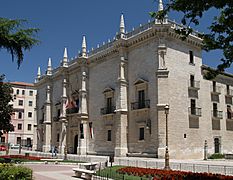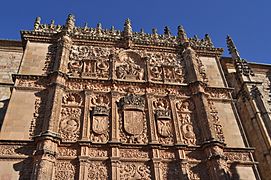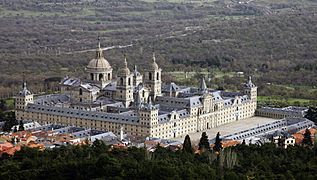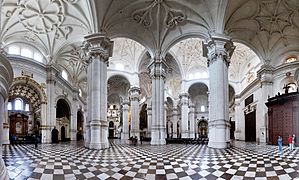Spanish Renaissance architecture facts for kids
Spanish Renaissance architecture is a special style of building that became popular in Spain in the late 1400s. It was inspired by the Renaissance style that started in Florence and Rome, Italy. This style brought back ideas from old Roman buildings.
In Spain, the Renaissance style mixed with the older Gothic style. This happened as smart builders and engineers learned new ways to design structures. During the time of King Felipe II (1556–1589), this new building style spread across Spain. It was helped by books about architecture from famous designers like Vitruvius and Palladio.
Contents
What is Spanish Renaissance Architecture?
The Spanish Renaissance style blended Italian ideas with older Spanish building traditions. Local architects helped this style grow, creating something unique to Spain. They mixed Italian designs, sometimes seen in books and paintings, with Gothic traditions and local tastes.
The Plateresque Style
The first part of Spanish Renaissance architecture is called Plateresque. This name comes from the Spanish word "platero," meaning silversmith. Buildings in this style have very detailed decorations on their outside walls. These decorations look like the fancy work of a silversmith.
Plateresque buildings often use classic Roman columns and candle-like designs. These are put together in balanced patterns. Good examples are the fronts of the University of Salamanca and the Convent of San Marcos in León.
-
The Palacio de Santa Cruz in Valladolid, an early Renaissance building.
The Purism Style
As time went on, the Gothic influences slowly disappeared. Architects started to focus more on pure, classic Roman styles. While Plateresque was common for a long time, some architects developed a simpler, more serious style. This phase is known as Purism.
Important architects of the Purism style included Diego Siloe and Andrés de Vandelvira in Andalusia. In Castile, Alonso de Covarrubias and Rodrigo Gil de Hontañón were key figures. Their designs were less decorated and more focused on clear, strong shapes.
-
The courtyard of the Palace of Charles V in Granada.
-
El Escorial, a huge building finished in 1584.
-
Inside the Granada Cathedral.
The Herrerian Style
From the mid-1500s, architects like Pedro Machuca, Juan Bautista de Toledo, and Juan de Herrera followed ancient Roman art even more closely. This sometimes led to a style called Mannerism, which was a step between Renaissance and Baroque.
A great example is the Palace of Charles V in Granada, built by Pedro Machuca. A new style, called Herrerian, began with the work of Juan Bautista de Toledo and Juan de Herrera at El Escorial. This style is very plain and simple. It uses granite stone blocks very well, creating a strong and grand look. The Herrerian style influenced Spanish buildings for over a hundred years, both in Spain and its colonies.
During this time (around 1559–1567), Spanish builders changed how they worked. They combined designing and building into one process. One professional was in charge of the whole design and stayed involved until the building was finished.
Famous Spanish Renaissance Buildings
Here are some notable structures built in the Spanish Renaissance style:
- El Escorial (by Juan Bautista de Toledo and Juan de Herrera)
- University of Salamanca (architect unknown)
- New Cathedral of Salamanca (by Juan de Álava and others)
- Palace of Monterrey in Salamanca (by Rodrigo Gil de Hontañón)
- Arzobispo Fonseca College in Salamanca (by Diego de Siloé, Juan de Álava and R. G. de Hontañón)
- Convent of San Esteban in Salamanca (by Juan de Álava and R. G. de Hontañón)
- Palace of Guzmanes in León (by R. G. de Hontañón)
- Hospital de la Santa Cruz in Toledo (by Enrique Egas and Alonso de Covarrubias)
- Hospital de Tavera in Toledo (by Bartolomé Bustamante)
- Hospital Real in Granada (by Enrique Egas)
- Palace of Charles V in Granada (by Pedro Machuca)
- Cathedral of Granada (by Juan Gil de Hontañón, Enrique Egas and Diego de Siloé)
- Jaén Cathedral (by Andrés de Vandelvira)
- Cathedral of Baeza (by Vandelvira)
- Vázquez de Molina Square in Úbeda (by Vandelvira)
- Town Hall in Seville (by Diego de Riaño)
- University of Alcalá de Henares (by Rodrigo Gil de Hontañón and others)
- Royal Collegiate Church of Santa María la Mayor in Antequera, Andalusia (by Pedro del Campo)
- Hostal de los Reyes Católicos of Santiago de Compostela (by Enrique Egas)
- Town Hall of Tarazona
See also
 In Spanish: Arquitectura renacentista española para niños
In Spanish: Arquitectura renacentista española para niños







